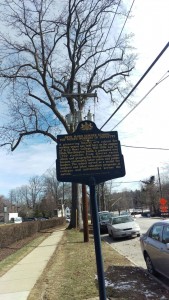I stopped on my way back to campus this morning to take a picture of the sign documenting the Summer School for Women Workers by the Admissions Building, thinking that perhaps I would use that as the basis for my response paper. 
Fortunately, before I did this, I decided to revisit the post I wrote around this time last year, when we touched on the Summer School in Monica’s History of Women’s Education course. As it happens, I had fixated on the sign last year, too (which is perhaps not surprising, given my interests, but somewhat amusing all the same). For anyone who is really bored, the full response is here — http://historyb332.blogs.brynmawr.edu/what-we-remember/ — but the gist of it is as follows:
- We learn very selectively about Bryn Mawr’s history from physical landmarks, particularly when it comes to the signs put up by the PA Historical Commission
- In the grand scheme of things, these signs aren’t really helping us learn a whole lot about Bryn Mawr as a school (the other sign is about Woodrow Wilson, but I will refrain from discussing my very strong opinion on that for the time being)
- However, when it comes to the Summer School, the sign is doing an excellent job: it’s the only way most of us learn about this aspect of Bryn Mawr’s history
Revisiting this argument a year later, it seems that much has changed and yet nothing has. On the one hand, I know Monica taught about the Summer School during last year’s Community Day of Learning and will do so again this year, and I know she’s also taken opportunities to discuss it elsewhere, both on this campus and off. And yet– how many people on this campus actually know about the Summer School? Should we care if they don’t?
As a history major, my response (of course we should! Everyone should know about this!) is probably biased, and yet I hope that my reasoning is not inaccessible to a larger audience. Everyone on this campus cares about Bryn Mawr, and on some level or another, almost everyone has a stake in how stories about this campus are told. What better way to distinguish Bryn Mawr to a dubious relative than to say it was the first college to offer women doctoral degrees in the U.S. or to explain the opportunities that a genuinely revolutionary summer school gave to students who might not have had them otherwise? Conversely, what better way to expose Bryn Mawr’s hypocritical policies and push for change than to show the advancement the Summer School made with regards to race and class while the College itself lagged several decades behind?
If it is indeed important to learn about the Summer School, which I think it is for more reasons than listed here, how might we go about bringing it to the attention of larger audiences? Despite my general feelings on the signs at Bryn Mawr (again, see last year’s comments if you really want to get into it) I think the Summer School sign is a good start. So are initiatives like Monica’s that bring it to audiences who might not have encountered it further. But perhaps bringing the Summer School into greater prominence physically– e.g., having a sign (put up by the College, rather than the PA Historical Commission, which I think would say a lot about Bryn Mawr’s active investment in its own history) in a more prominent place on campus, or showcasing the words of the Summer School graduates in the Campus Center the way we do our regular alumnae– might also help. Suffice to say that I would really like to learn more about physical landmarks in general and how they impact the way we view history– and that I would very much like to consider the potential effect they might have on our campus.
